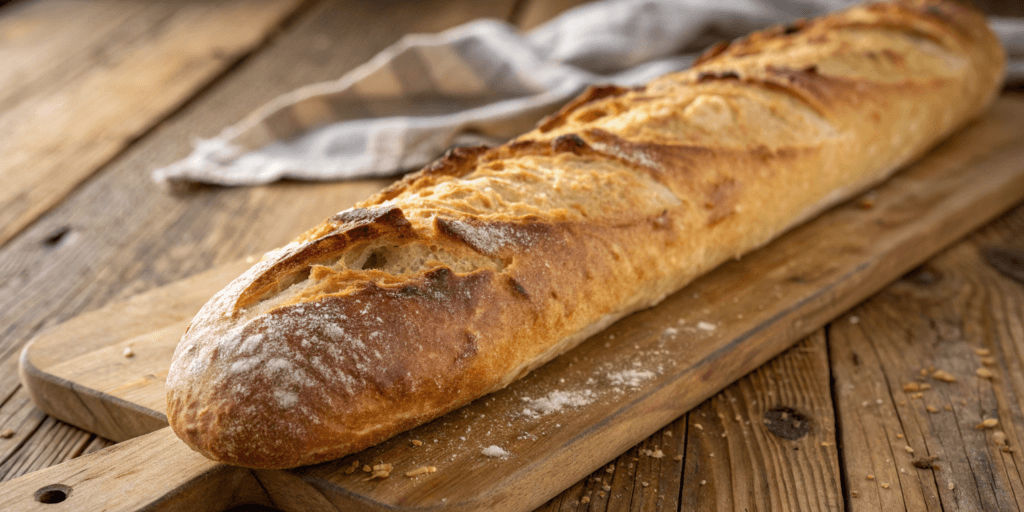Craving the crispy crust and soft, chewy inside of a freshly baked baguette? You’re not alone. Whether it’s to impress guests at dinner or simply elevate your sandwich game, this easy baguette recipe brings the iconic French loaf to your kitchen—no fancy equipment or bakery skills required.
Originating from France, the baguette is a long, thin loaf known for its crisp crust and airy interior. It’s deeply rooted in French culture, often eaten with cheese, meats, or simply butter. The baking process may seem intimidating, but understanding a few fundamentals will make it surprisingly manageable.

If you’ve ever wondered what is the secret to a good baguette, much of the answer lies in the process of fermentation, flour quality, and baking technique. In fact, under the baguette law in France (yes, it’s real!), traditional baguettes must be made with just four ingredients—flour, water, salt, and yeast—prohibiting preservatives or additives. That simplicity is part of what makes them so special.
Table of Contents
Ingredients List baguette recipe
Here’s what you’ll need to make 2 classic baguettes:
- 3 ½ cups (420g) bread flour
- 1 ½ teaspoons salt
- 1 teaspoon sugar
- 1 teaspoon active dry yeast
- 1 ¼ cups (300ml) warm water (about 110°F)
- 1 tablespoon olive oil (optional for added softness)
How to Make a Baguette (Step-by-Step Instructions)
Follow these simple steps for a quick and delicious homemade baguette:
Step 1: Activate the Yeast
In a small bowl, combine the warm water, sugar, and yeast. Stir and let sit for 5–10 minutes until foamy. This step ensures your yeast is alive and ready.
Step 2: Make the Dough
In a large bowl, mix flour and salt. Pour in the yeast mixture and stir until a sticky dough forms. Knead the dough on a lightly floured surface for about 8–10 minutes, or until smooth and elastic.
Step 3: First Rise
Place dough in a greased bowl, cover it with a damp cloth, and let it rise in a warm spot for 1 to 1.5 hours, until doubled in size.
Step 4: Shape the Baguettes
Gently punch down the dough and divide it in half. Shape each piece into a long log (about 12–14 inches) and place on a floured baking sheet or baguette pan.
Step 5: Second Rise
Cover loosely with a towel and let rise again for 30–45 minutes.
Step 6: Score and Bake
Preheat oven to 450°F (230°C). Use a sharp knife or razor to score 3–4 diagonal slashes on each loaf. Bake for 20–25 minutes, or until golden brown and hollow-sounding when tapped.
Expert Tips for Perfect Baguettes
Want to know what is the secret to a good baguette? It’s all in the hydration, fermentation, and baking environment. Here’s how to nail it every time:
- Use bread flour for stronger gluten structure and chew.
- Steam the oven: Place a pan of hot water on the bottom rack for crusty perfection.
- Let it rest: A longer fermentation (overnight in the fridge) can develop more flavor.
- Score with confidence: Deep, clean slashes allow for controlled expansion during baking.
Ingredient Swaps (If You’re in a Pinch)
- Bread flour → All-purpose flour: Slightly less chewy but still works.
- Active dry yeast → Instant yeast: Skip the proofing, mix it straight into the flour.
- Olive oil (optional): Makes for a slightly softer baguette if preferred.
Additional Recipe Information
| Detail | Info |
|---|---|
| Prep Time | 15 minutes |
| Rising Time | 2 hours |
| Cook Time | 25 minutes |
| Total Time | ~2 hours 40 minutes |
| Servings | 2 full baguettes |
| Freezer-Friendly | Yes, up to 3 months |
| Difficulty Level | Beginner-friendly |
Nutritional Info (Per Serving)
(Approximate per slice, assuming 16 slices total)
- Calories: 120
- Carbs: 25g
- Protein: 4g
- Fat: 0.5g
- Sugar: <1g
- Fiber: 1g
Frequently Asked Questio
What is the secret to a good baguette?
A great baguette comes down to proper hydration, long fermentation, and steam during baking to achieve the signature crust and soft interior.
What’s the difference between a baguette and a French baguette?
Technically, all baguettes are French, but the term “French baguette” often refers to the traditional method using only flour, water, yeast, and salt—no additives.
What is the baguette law in France?
Known as the “Décret Pain,” French law requires a traditional baguette to contain only four ingredients: flour, water, salt, and yeast. No preservatives allowed.
Are baguettes difficult to make?
Not at all! While the process may seem intimidating, our step-by-step recipe simplifies things so anyone can succeed—even first-timers.
- The cooking doesn’t stop here!
Try delicious recipes like How to Make Coconut Lime Cake andKey Lime Cake— let the flavors keep surprising you.
Give It a Try!
Now that you’ve learned what is the secret to a good baguette, it’s your turn to give this recipe a shot! Whether for a hearty sandwich, cheese platter, or just fresh from the oven with butter—this homemade baguette will become your go-to.
Tried it? Leave a comment below and let us know how it turned out.
Don’t forget to rate the recipe and share your delicious creation on Instagram!
